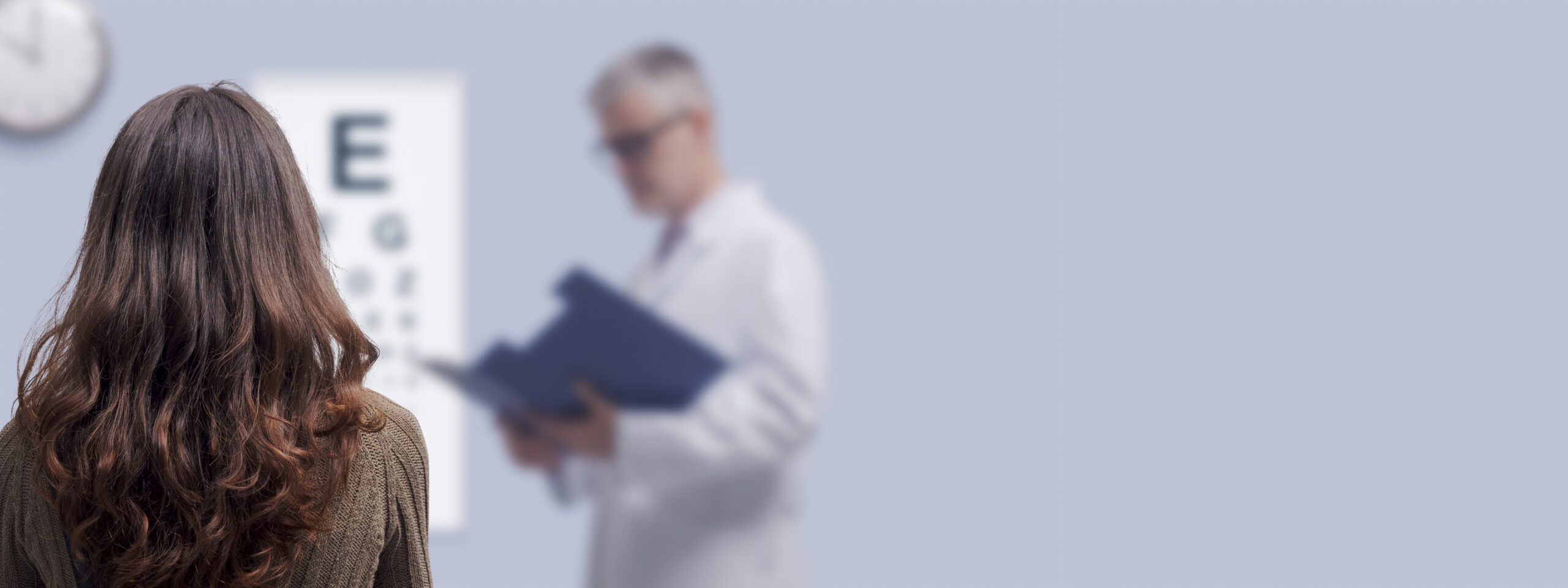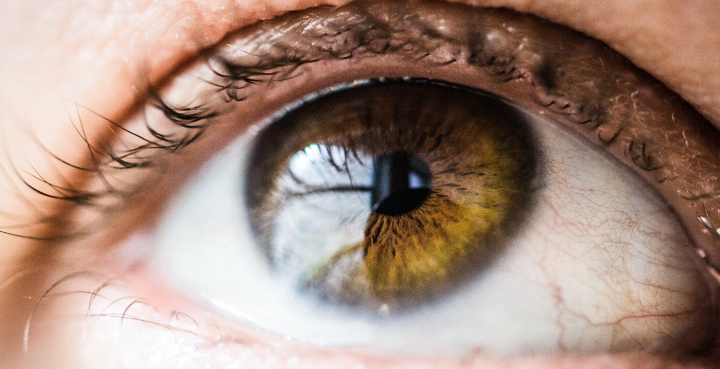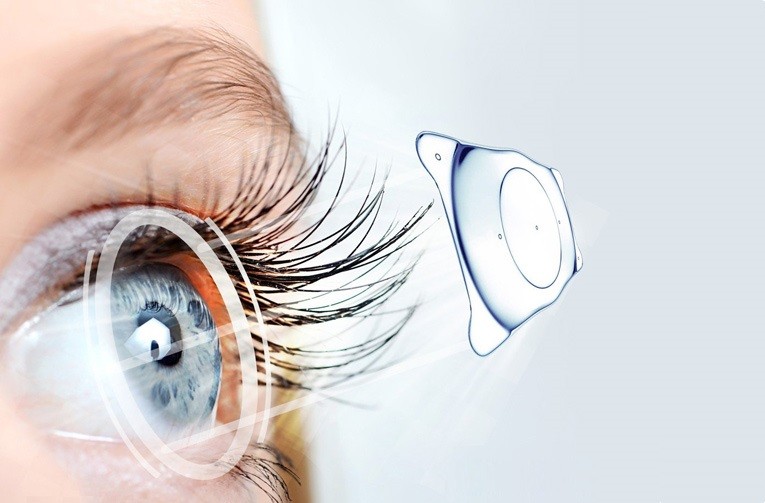
Prima Medical Center Saigon, Refractive and Lasik, Eyes
Types of Refractive Errors and Solutions
19 August, 2023
What are refractive errors?
Normal eye is the one that has no abnormal signs in the optical system (cornea, lens, vitreous humor), so the light rays from infinity are properly focused on the retina, give us clear vision. In contrast, the eye with refractive error is the one with abnormalities in its optical component(s), causing the light rays to focus in front of or behind the retina, resulting in blurred vision.

Refractive errors cause reduced visual capacity, eyestrain, curl of the eyelids, affecting daily life activities and quality of life. In some cases, refractive errors can cause strabismus and amblyopia.
Causes of refractive errors
- Congenital, genetic refractive errors.
- Damage caused by an eye injury.
- Cause by subjective and habit-related factors such as time, level, and intensity of eye use.
- Ambient environment, including too low intensity of light, too short distance to the objects to be observed.
Refractive errors cause reduced visual capacity and affect daily life activities and quality of life.
Classification of Refractive Errors
Myopia (also known as near-sightedness or short-sightedness)
In the nearsighted eye, the focal point of light rays is in front of the retina, so the near-sighted person can see the close objects clearly while having a blurred vision for distant objects.
One of the most common causes of myopia is that the force of refraction is greater than normal. If the eye sees close objects too often for a long period of time, the lens will be budged, resulting in an increase of the corneal curvature, thereby changing the refractive index of the eye. In addition, myopia is caused by an eyeball whose axis is longer than normal, mainly coming with serious consequences, including vision impairment, quickly increased myopic severity and adverse impacts on the retina.

Common symptoms of myopia are a blurry vision when looking at distant objects, eyestrain, frequent squinting, blinking, and fatigue, which can be accompanied by headaches.
In terms of congenital factor, those whose parents were nearsighted are 20-30% more likely to have myopia, and it is 2.5% for those whose parents are not. If based on daily habits, those who usually learn or work in an insufficient light environment, see the electric screen at a close distance to the eye, are at higher risk of myopia than the others.
Myopia can be prevented by adjusting your lifestyle and habits. For instance, keeping correct posture, keeping a reasonable distance between the eyes and electronic screens in studying, working, limiting use of electronic devices in the dark, increasing the frequency of rest between working hours and doing eye exercise by applying the 20-20-20 rule (Every 20 minutes, take a 20-second break and focus your eyes on something at least 20 feet away – about 6 meters).
Hyperopia (also known as farsightedness or long-sightedness)
In the farsighted eye, light entering the eye will converge behind the eyeball, making those who are farsighted have more trouble seeing things that are close up than things that are far away.
Hyperopia is caused by an eyeball whose axis is shorter than normal. There are also a number of other causes of a lower rate such as weak refractive force, the flat cornea (small corneal curvature), corneal scarring, etc.

Common symptoms of hyperopia are trouble focusing on nearby objects, headache, eyestrain, fatigue, or dizziness after doing a close-up task such as reading books.
Most infants are hyperopic at birth as the eyeball does not completely develop and their axis is short. This defect is gradually corrected as the eye develops in proportion to the body growth, bringing their eyes to normal.
Because hyperopia is caused by the eye structure, there is no preventive measure.
Astigmatism
In an astigmatism eye, light rays are focused at several different points on the retina, instead of a single point, causing blurred and dizzying vision. It’s common to have astigmatism along with myopia or hyperopia. The most common cause is that the cornea has an irregular spherical shape, which prevents light from focusing properly on the axes.

Common symptoms of astigmatism are blurred or distorted vision at all distances, double vision, difficulty with night vision, eyestrain, etc.
Both adults and children are at risk of astigmatism. The risk is higher for a child with a parent having astigmatism or corneal abnormalities such as a corneal scar or keratoconus.
In addition to genetic or congenital astigmatism, developed astigmatism can be prevented by taking good care of the eye. Habits such as working inadequate lighting conditions, taking rest to avoid fatigue, eye pressure, and doing eye exercises at break time are all effective in preventing astigmatism.
Methods of Correcting Refractive Errors
People with refractive errors can improve their vision by wearing glasses, using the Ortho-K contact lenses, or opting for surgery to treat myopia, hyperopia, and astigmatism.
Wearing glasses
After the vision test, the patient will be given a prescription with the correct refractive index in the eye. He/she then can choose to wear framed glasses or soft contact lenses. It is highly recommended that the patients should continuously wear glasses of proper diopters to limit myopia progression and avoid the risk of amblyopia.
Temporary cornea reshaping by using Ortho-K contact lenses
People with nearsightedness and astigmatism can choose Ortho-K – the cornea reshaping method associated with overnight hard contact lenses. By wearing them overnight (around 6 – 8 hours per night on average), and removing them upon waking up, Ortho-K helps reshape the cornea, thereby temporarily eliminating refractive power, allowing patients to participate in daytime activities without wearing framed glasses or contact lenses. Ortho K is also considered an effective method in controlling myopia progression in children.
Surgery to treat refractive errors
Lasik Surgery
Lasik is a surgery using a microsurgical auto-blade to create the corneal flap, multi-point laser to remove refractive power, finally return the corneal flap to its original position. This method is suitable for eyes with a medium refractive level (less than 6 diopters) with acceptable corneal thickness.
Femtosecond Lasik Surgery
Femtosecond Lasik uses a Femtosecond laser to create the corneal flap, a multi-point laser to remove refractive power, and finally return the corneal flap to its original position. The knife-free mechanism makes the incision more precise. This method is suitable for eyes with a medium refractive level (less than 6 diopters) with acceptable corneal thickness.
Relex SMILE Surgery
This is a minimally invasive surgery which neither flaps the cornea, nor uses any mechanical blade, but only uses a laser ray to illuminate through the corneal surface, cutting the cornea into 2 layers, through a 2mm micro-incision to remove the tissue that has just been cut. ReLEx SMILE is considered the most advanced laser-based myopia surgery today. It is suitable for eyes of less than 8 diopters of nearsightedness with guaranteed corneal thickness.
Phakic Surgery
Phakic is a surgery for nearsightedness that involves placing an intraocular lens designed following the structure of the patient’s eye behind the iris and in front of the crystal lens to correct the refractive index.

Phakic ICL
Phakic can correct the nearsightedness of up to 18 diopters, farsightedness of up to10 diopters, and astigmatism of up to 6 diopters with ICL lens and can correct the nearsightedness of up to 30 diopters, farsightedness of up to 15 diopters, and astigmatism of up to 10 diopters.
By preserving the corneal structure, Phakic is the optimal solution for eyes with a thin cornea, cases rejected for laser-based surgery.
Our Lasik & Refractive Care Team:
- Dr THAO Vo, Chief Medical Officer, Prima Medical Center Saigon
- Dr QUYNH Ha, Senior Consultant (Refractive & Lasik)
- Dr TRAN Nguyen, Consultant
What are refractive errors?
Normal eye is the one that has no abnormal signs in the optical system (cornea, lens, vitreous humor), so the light rays from infinity are properly focused on the retina, give us clear vision. In contrast, the eye with refractive error is the one with abnormalities in its optical component(s), causing the light rays to focus in front of or behind the retina, resulting in blurred vision.

Refractive errors cause reduced visual capacity, eyestrain, curl of the eyelids, affecting daily life activities and quality of life. In some cases, refractive errors can cause strabismus and amblyopia.
Causes of refractive errors
- Congenital, genetic refractive errors.
- Damage caused by an eye injury.
- Cause by subjective and habit-related factors such as time, level, and intensity of eye use.
- Ambient environment, including too low intensity of light, too short distance to the objects to be observed.
Refractive errors cause reduced visual capacity and affect daily life activities and quality of life.
Classification of Refractive Errors
Myopia (also known as near-sightedness or short-sightedness)
In the nearsighted eye, the focal point of light rays is in front of the retina, so the near-sighted person can see the close objects clearly while having a blurred vision for distant objects.
One of the most common causes of myopia is that the force of refraction is greater than normal. If the eye sees close objects too often for a long period of time, the lens will be budged, resulting in an increase of the corneal curvature, thereby changing the refractive index of the eye. In addition, myopia is caused by an eyeball whose axis is longer than normal, mainly coming with serious consequences, including vision impairment, quickly increased myopic severity and adverse impacts on the retina.

Common symptoms of myopia are a blurry vision when looking at distant objects, eyestrain, frequent squinting, blinking, and fatigue, which can be accompanied by headaches.
In terms of congenital factor, those whose parents were nearsighted are 20-30% more likely to have myopia, and it is 2.5% for those whose parents are not. If based on daily habits, those who usually learn or work in an insufficient light environment, see the electric screen at a close distance to the eye, are at higher risk of myopia than the others.
Myopia can be prevented by adjusting your lifestyle and habits. For instance, keeping correct posture, keeping a reasonable distance between the eyes and electronic screens in studying, working, limiting use of electronic devices in the dark, increasing the frequency of rest between working hours and doing eye exercise by applying the 20-20-20 rule (Every 20 minutes, take a 20-second break and focus your eyes on something at least 20 feet away – about 6 meters).
Hyperopia (also known as farsightedness or long-sightedness)
In the farsighted eye, light entering the eye will converge behind the eyeball, making those who are farsighted have more trouble seeing things that are close up than things that are far away.
Hyperopia is caused by an eyeball whose axis is shorter than normal. There are also a number of other causes of a lower rate such as weak refractive force, the flat cornea (small corneal curvature), corneal scarring, etc.

Common symptoms of hyperopia are trouble focusing on nearby objects, headache, eyestrain, fatigue, or dizziness after doing a close-up task such as reading books.
Most infants are hyperopic at birth as the eyeball does not completely develop and their axis is short. This defect is gradually corrected as the eye develops in proportion to the body growth, bringing their eyes to normal.
Because hyperopia is caused by the eye structure, there is no preventive measure.
Astigmatism
In an astigmatism eye, light rays are focused at several different points on the retina, instead of a single point, causing blurred and dizzying vision. It’s common to have astigmatism along with myopia or hyperopia. The most common cause is that the cornea has an irregular spherical shape, which prevents light from focusing properly on the axes.

Common symptoms of astigmatism are blurred or distorted vision at all distances, double vision, difficulty with night vision, eyestrain, etc.
Both adults and children are at risk of astigmatism. The risk is higher for a child with a parent having astigmatism or corneal abnormalities such as a corneal scar or keratoconus.
In addition to genetic or congenital astigmatism, developed astigmatism can be prevented by taking good care of the eye. Habits such as working inadequate lighting conditions, taking rest to avoid fatigue, eye pressure, and doing eye exercises at break time are all effective in preventing astigmatism.
Methods of Correcting Refractive Errors
People with refractive errors can improve their vision by wearing glasses, using the Ortho-K contact lenses, or opting for surgery to treat myopia, hyperopia, and astigmatism.
Wearing glasses
After the vision test, the patient will be given a prescription with the correct refractive index in the eye. He/she then can choose to wear framed glasses or soft contact lenses. It is highly recommended that the patients should continuously wear glasses of proper diopters to limit myopia progression and avoid the risk of amblyopia.
Temporary cornea reshaping by using Ortho-K contact lenses
People with nearsightedness and astigmatism can choose Ortho-K – the cornea reshaping method associated with overnight hard contact lenses. By wearing them overnight (around 6 – 8 hours per night on average), and removing them upon waking up, Ortho-K helps reshape the cornea, thereby temporarily eliminating refractive power, allowing patients to participate in daytime activities without wearing framed glasses or contact lenses. Ortho K is also considered an effective method in controlling myopia progression in children.
Surgery to treat refractive errors
Lasik Surgery
Lasik is a surgery using a microsurgical auto-blade to create the corneal flap, multi-point laser to remove refractive power, finally return the corneal flap to its original position. This method is suitable for eyes with a medium refractive level (less than 6 diopters) with acceptable corneal thickness.
Femtosecond Lasik Surgery
Femtosecond Lasik uses a Femtosecond laser to create the corneal flap, a multi-point laser to remove refractive power, and finally return the corneal flap to its original position. The knife-free mechanism makes the incision more precise. This method is suitable for eyes with a medium refractive level (less than 6 diopters) with acceptable corneal thickness.
Relex SMILE Surgery
This is a minimally invasive surgery which neither flaps the cornea, nor uses any mechanical blade, but only uses a laser ray to illuminate through the corneal surface, cutting the cornea into 2 layers, through a 2mm micro-incision to remove the tissue that has just been cut. ReLEx SMILE is considered the most advanced laser-based myopia surgery today. It is suitable for eyes of less than 8 diopters of nearsightedness with guaranteed corneal thickness.
Phakic Surgery
Phakic is a surgery for nearsightedness that involves placing an intraocular lens designed following the structure of the patient’s eye behind the iris and in front of the crystal lens to correct the refractive index.

Phakic ICL
Phakic can correct the nearsightedness of up to 18 diopters, farsightedness of up to10 diopters, and astigmatism of up to 6 diopters with ICL lens and can correct the nearsightedness of up to 30 diopters, farsightedness of up to 15 diopters, and astigmatism of up to 10 diopters.
By preserving the corneal structure, Phakic is the optimal solution for eyes with a thin cornea, cases rejected for laser-based surgery.
Our Lasik & Refractive Care Team:
- Dr THAO Vo, Chief Medical Officer, Prima Medical Center Saigon
- Dr QUYNH Ha, Senior Consultant (Refractive & Lasik)
- Dr TRAN Nguyen, Consultant



